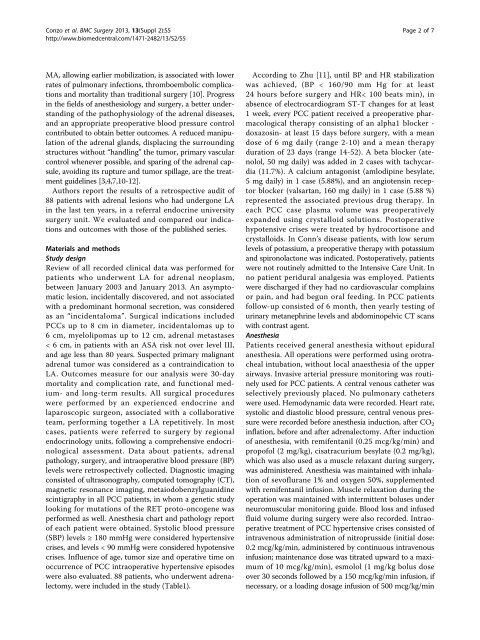Laparoscopic adrenal surgery: ten-year ... - BioMed Central
Laparoscopic adrenal surgery: ten-year ... - BioMed Central
Laparoscopic adrenal surgery: ten-year ... - BioMed Central
You also want an ePaper? Increase the reach of your titles
YUMPU automatically turns print PDFs into web optimized ePapers that Google loves.
Conzo et al. BMC Surgery 2013, 13(Suppl 2):S5<br />
http://www.biomedcentral.com/1471-2482/13/S2/S5<br />
Page 2 of 7<br />
MA, allowing earlier mobilization, is associated with lower<br />
rates of pulmonary infections, thromboembolic complications<br />
and mortality than traditional <strong>surgery</strong> [10]. Progress<br />
in the fields of anesthesiology and <strong>surgery</strong>, a better understanding<br />
of the pathophysiology of the <strong>adrenal</strong> diseases,<br />
and an appropriate preoperative blood pressure control<br />
contributed to obtain better outcomes. A reduced manipulation<br />
of the <strong>adrenal</strong> glands, displacing the surrounding<br />
structures without “handling” the tumor, primary vascular<br />
control whenever possible, and sparing of the <strong>adrenal</strong> capsule,<br />
avoiding its rupture and tumor spillage, are the treatment<br />
guidelines [3,4,7,10-12].<br />
Authors report the results of a retrospective audit of<br />
88 patients with <strong>adrenal</strong> lesions who had undergone LA<br />
in the last <strong>ten</strong> <strong>year</strong>s, in a referral endocrine university<br />
<strong>surgery</strong> unit. We evaluated and compared our indications<br />
and outcomes with those of the published series.<br />
Materials and methods<br />
Study design<br />
Review of all recorded clinical data was performed for<br />
patients who underwent LA for <strong>adrenal</strong> neoplasm,<br />
between January 2003 and January 2013. An asymptomatic<br />
lesion, incidentally discovered, and not associated<br />
with a predominant hormonal secretion, was considered<br />
as an “incidentaloma”. Surgical indications included<br />
PCCs up to 8 cm in diameter, incidentalomas up to<br />
6 cm, myelolipomas up to 12 cm, <strong>adrenal</strong> metastases<br />
< 6 cm, in patients with an ASA risk not over level III,<br />
and age less than 80 <strong>year</strong>s. Suspected primary malignant<br />
<strong>adrenal</strong> tumor was considered as a contraindication to<br />
LA. Outcomes measure for our analysis were 30-day<br />
mortality and complication rate, and functional medium-<br />
and long-term results. All surgical procedures<br />
were performed by an experienced endocrine and<br />
laparoscopic surgeon, associated with a collaborative<br />
team, performing together a LA repetitively. In most<br />
cases, patients were referred to <strong>surgery</strong> by regional<br />
endocrinology units, following a comprehensive endocrinological<br />
assessment. Data about patients, <strong>adrenal</strong><br />
pathology, <strong>surgery</strong>, and intraoperative blood pressure (BP)<br />
levels were retrospectively collected. Diagnostic imaging<br />
consisted of ultrasonography, computed tomography (CT),<br />
magnetic resonance imaging, metaiodobenzylguanidine<br />
scintigraphy in all PCC patients, in whom a genetic study<br />
looking for mutations of the RET proto-oncogene was<br />
performed as well. Anesthesia chart and pathology report<br />
of each patient were obtained. Systolic blood pressure<br />
(SBP) levels ≥ 180 mmHg were considered hyper<strong>ten</strong>sive<br />
crises, and levels < 90 mmHg were considered hypo<strong>ten</strong>sive<br />
crises. Influence of age, tumor size and operative time on<br />
occurrence of PCC intraoperative hyper<strong>ten</strong>sive episodes<br />
were also evaluated. 88 patients, who underwent <strong>adrenal</strong>ectomy,<br />
were included in the study (Table1).<br />
According to Zhu [11], until BP and HR stabilization<br />
was achieved, (BP < 160/90 mm Hg for at least<br />
24 hours before <strong>surgery</strong> and HR< 100 beats min), in<br />
absence of electrocardiogram ST-T changes for at least<br />
1 week, every PCC patient received a preoperative pharmacological<br />
therapy consisting of an alpha1 blocker -<br />
doxazosin- at least 15 days before <strong>surgery</strong>, with a mean<br />
dose of 6 mg daily (range 2-10) and a mean therapy<br />
duration of 23 days (range 14-52). A beta blocker (a<strong>ten</strong>olol,<br />
50 mg daily) was added in 2 cases with tachycardia<br />
(11.7%). A calcium antagonist (amlodipine besylate,<br />
5 mg daily) in 1 case (5.88%), and an angio<strong>ten</strong>sin receptor<br />
blocker (valsartan, 160 mg daily) in 1 case (5.88 %)<br />
represented the associated previous drug therapy. In<br />
each PCC case plasma volume was preoperatively<br />
expanded using crystalloid solutions. Postoperative<br />
hypo<strong>ten</strong>sive crises were treated by hydrocortisone and<br />
crystalloids. In Conn’s disease patients, with low serum<br />
levels of potassium, a preoperative therapy with potassium<br />
and spironolactone was indicated. Postoperatively, patients<br />
were not routinely admitted to the In<strong>ten</strong>sive Care Unit. In<br />
no patient peridural analgesia was employed. Patients<br />
were discharged if they had no cardiovascular complains<br />
or pain, and had begun oral feeding. In PCC patients<br />
follow-up consisted of 6 month, then <strong>year</strong>ly testing of<br />
urinary metanephrine levels and abdominopelvic CT scans<br />
with contrast agent.<br />
Anesthesia<br />
Patients received general anesthesia without epidural<br />
anesthesia. All operations were performed using orotracheal<br />
intubation, without local anaesthesia of the upper<br />
airways. Invasive arterial pressure monitoring was routinely<br />
used for PCC patients. A central venous catheter was<br />
selectively previously placed. No pulmonary catheters<br />
were used. Hemodynamic data were recorded. Heart rate,<br />
systolic and diastolic blood pressure, central venous pressure<br />
were recorded before anesthesia induction, after CO 2<br />
inflation, before and after <strong>adrenal</strong>ectomy. After induction<br />
of anesthesia, with remifentanil (0.25 mcg/kg/min) and<br />
propofol (2 mg/kg), cisatracurium besylate (0.2 mg/kg),<br />
which was also used as a muscle relaxant during <strong>surgery</strong>,<br />
was administered. Anesthesia was maintained with inhalation<br />
of sevoflurane 1% and oxygen 50%, supplemented<br />
with remifentanil infusion. Muscle relaxation during the<br />
operation was maintained with intermit<strong>ten</strong>t boluses under<br />
neuromuscular monitoring guide. Blood loss and infused<br />
fluid volume during <strong>surgery</strong> were also recorded. Intraoperative<br />
treatment of PCC hyper<strong>ten</strong>sive crises consisted of<br />
intravenous administration of nitroprusside (initial dose:<br />
0.2 mcg/kg/min, administered by continuous intravenous<br />
infusion; main<strong>ten</strong>ance dose was titrated upward to a maximum<br />
of 10 mcg/kg/min), esmolol (1 mg/kg bolus dose<br />
over 30 seconds followed by a 150 mcg/kg/min infusion, if<br />
necessary, or a loading dosage infusion of 500 mcg/kg/min
















